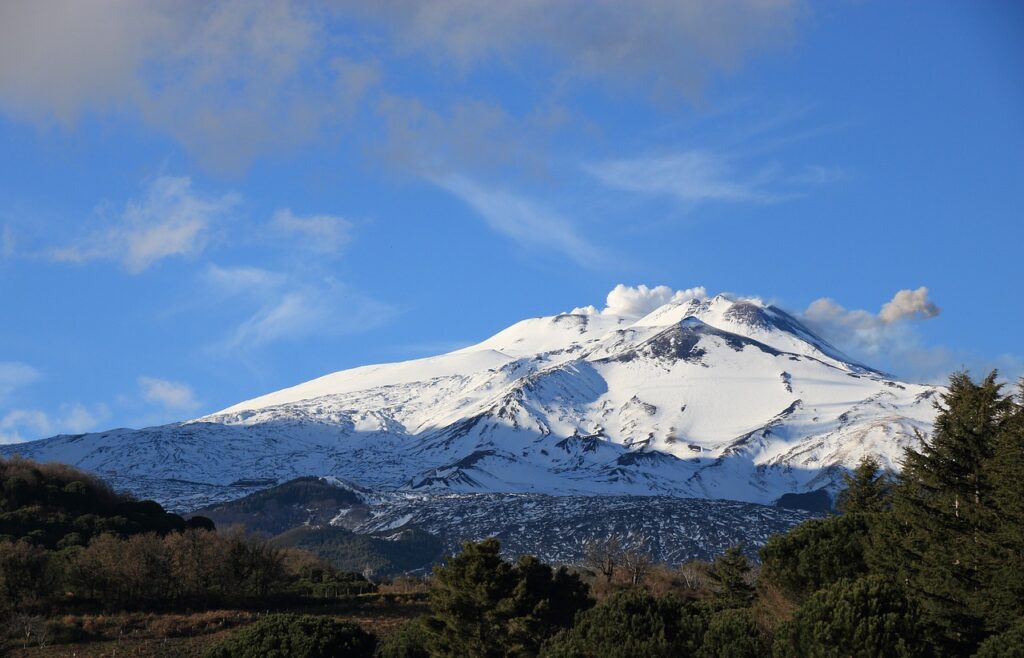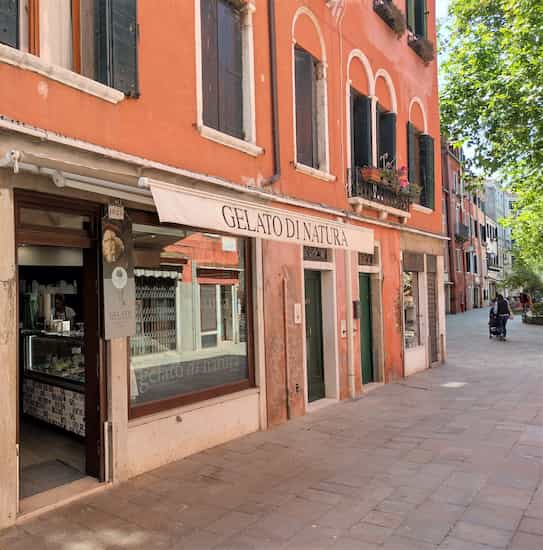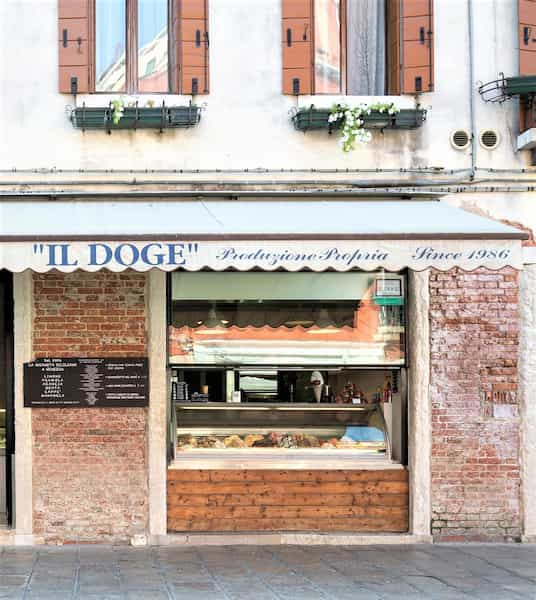
Got directly to Ice Cream in Venice.
The history of Ice cream… A background.
Ice cream is a very old phenomenon. It started a long time ago… Thousands of years ago in fact. But, as always, it’s kind of difficult to determine at what exact day. Because first, we have to define what ice cream really is.
Ice cream is a sweetened frozen food typically eaten as a snack or dessert.
That is a direct quote from Wikipedia, and it includes almost anything. If we determine ice cream like that, then the origins are very old. The very first such things possibly arose in the ancient Persian (Achaemenid) Empire.
What they did was simply to take snow or ice, put a sweetener on it, like honey, and maybe decorate it with some berries, and the ice cream was born. It then came to Rome, to the Arabic world, and from there to Sicily and back to Europe. Maybe… Because we don’t know for sure how it spread.
Eating an ice cream would surely have been an awesome experience if you lived in the warm part of the world. But there the problem would have been to actually find the snow. On the other hand, in northern Europe, you have a lot of snow. I still don’t think the Vikings would have been all that keen on the newborn dessert. They would probably opt for hot chocolate.

Some historians put the origin on Sicily. The volcano Etna is over 3000 meters high and the top is white most part of the year. It’s not hard to imagine some ingenious businessman driving his mule to the top, bringing down the ice, and selling it with honey to the astonished fellow citizens panting in the heat of the unbearable Sicilian sun.
Then the real ice cream was invented.
The natural ice cream was more or less sweetened snow. With many different techniques and ingredients, the temperature and flavor changed, but the result was more like a sorbet, or a granita.
That changed very slowly and gradually during the centuries. Some adventurous ice cream makers changed the ingredients from water/ice to milk/cream. But it wasn’t until the mid-1800 that an artificial ice cream maker was introduced. In 1843, Nancy M. Johnson from New York created a hand-cranked ice cream machine. The machine still used ice and salt for the freezing process.
In 1854 James Harrison invented an electric ice cream maker that used a compressor, a refrigeration gas, and a condenser much like modern refrigerators. And from there, it became possible to produce the frozen delight completely artificially.
Here are a few landmarks.
- 1559. Bernardo Buontalenti, Florens, Italy supposedly invented an ice cream with milk, honey, egg yolk, wine, aromatized with bergamot, lemon, and orange. It is also suggested that he actually invented a machine to mix and freeze the ingredients. If it’s true, that would have been the very first ice cream maker ever.
- 1686 Francesco Procopio from Sicilly opened his ice cream shop in Paris. It soon became a highly fashionable establishment thanks to a series of technical inventions and new flavors.
- 1750- The usage of cones to put the ice cream in, started to become an option.
- 1770 Giovanni Basiolo introduces ice cream to the American public.
- 1775 The first-ever book entirely written about ice cream is published in Naples, Italy: On sorbets and frozen products, the medical and physical benefits.
- 1843 The first-ever ice cream maker… Though hand-cranked.
- 1854 The first-ever electric ice cream maker.
- 1903 Italo Marchioni, New York, invented an automated cone-baking machine.
- 1920 Harry Burt, Ohio, started selling frozen desserts from his truck. And the ice cream van was born.
- 1926 The continuous freezer was invented by Clarence Vogt. With his technique, ice cream could be produced faster, cheaper, and in greater volumes.
- 1939 The gelateria Pepino in Turin was the first to patent a coated ice cream on a stick.

Ice cream vs Gelato
In the US, there is a difference between ice cream and gelato. The national definitions of frozen desserts differ from country to country, but the distinction between ice cream and gelato is an American phenomenon. In Italy, it’s all gelato.
The differences are mainly three:
- Ice cream is fatter. It contains 14 to 25 % fat while gelato only has one-third of that.
- There’s more air in ice cream. That’s because it’s industrially produced and the whipping is faster with bigger machines.
- Ice cream is served at a lower temperature.
The truth of the matter is that there is no true border between the two. Industrially made things are different from things made in a small laboratory. That’s just the way it is. The more air is a consequence of the method with which it is made, and the lower temperature is a consequence of the more air. The fat is just a choice… It depends on how you want your ice cream.
One, you buy at the supermarket and often contains a long list of chemicals like preservatives, colorings, and thickeners… While the other is made right there, in front of you, and sold immediately.
And it is the second we are going for when we try to find the best ice cream in Venice…
Ice Cream in Venice
The ice cream in Venice can be found all over. The ice cream shops are usually small. Sometimes it’s just a kiosk with no internal space. Sometimes they have a few benches or tables outside, but in Venice that is rare.

- Tip 1 – Look for gelaterie – not bars. Often you see a bar with an attached freezer from where they sell ice cream. It could be good, but if you don’t know exactly where to go, then stay away. The gelato often isn’t as fresh as it should be, and it could have been transported and that could have risen the temperature too much.
- Tip 2 – Look inside the shop. Do they have a laboratory behind the backdoor? You can also ask and they will tell you. Many of the more famous gelaterie in Venice actually do not make their own ice cream. More about that later. Even if the gelato is good, transporting it is always a risk. The cold chain can be broken especially in the warm season.
- Tip 3 – Check the colors. Some flavors are good giveaways. Pistacchio (pronounced pist’ackio…), and fruits like melon and apple are just a few examples. But, with just a fast overlook you can sometimes determine if they use colorings. And if they do, then maybe they use other artificial ingredients as well, and we don’t want that.
- Tip 4 – Just like when choosing a restaurant, we don’t want too much of a choice. That has to be weighed against the flow of customers, but if a small, somewhat hidden ice cream shop has 30 different flavors, then it’s not fresh.

How the Gelato industry has changed in recent years.
Fifteen, twenty years ago, good ice cream in Venice… Gelato with natural ingredients made with knowledge and craftsmanship was pretty easy to find. But now, many of the smaller shops have gone over to making the ice cream with powder. They use real milk, cream, and eggs, but the flavors are from flavoring powders. It comes out quite decent, as the powder industry. like all other industries, improve, but it’s still fake.
If you want the real deal, it’s getting trickier day by day.
You can always ask. Very often the girl/boy who scoops the gelato is just hired for the season and doesn’t have much to hide. They will tell you the truth without hesitation.
And the ice cream shops I will tell you about here are sure bets.
The big names

- Grom has one shop in Campo San Barnaba, and one at the railway station. Grom is a big chain of gelaterie originating from Turin. Since 2015 it is owned by Unilever (!). The ice cream is good. Their slogan is “Ice cream like it once was”, and they use organic and generally good ingredients. But they don’t make their ice cream in Venice. It’s shipped there. It’s also rather expensive.
- Gelatoteca Suso, just a few steps from Rialto, is a very popular ice cream shop. It’s good with a vast variety of different tastes. The same thing that has been said about Grom can be said about Suso. They get their gelato shipped, and it’s expensive.
- Gelato di Natura is another ice cream shop chain. This one is from Scorzè on the mainland not far from Mestre. They have four shops in Venice. They use only the best ingredients and their ice cream has won prices and they sell their products in detail. (The Suso-ice cream is actually theirs…). But it’s still a gelato made elsewhere and transported to Venice. And that’s not really what we are looking for here.
So, over to the recommended Ice cream in Venice.
Here’s the ultimate list for ice cream in Venice:

- Gelateria Il Doge – They have two shops, one at Campo Santa Margherita, and the other a few steps from Campo San Tomà. They are both true gelaterie, with the owners working early, every morning to get the perfect ice cream out to the customers. This is as original and handcrafted as it gets.
- Gelateria Nico – Ok, this is the exception from the rule about the attached bar. They have coffee and drinks and stuff, but it’s still a very good gelateria. And if you want to be traditional, apart from the ice cream, you should try the “Gianduiotto a Passeggio”. A kind of frozen chocolate(hazelnut cream served in a paper mug with whipped cream. You buy it and just stroll along the seafront of Zattere.
- Gelateria Lo Squero – Close by Nico’s walking up towards Canal Grande, there is this very small ice cream shop on your right. Traditional flavors, but freshly made and with real stuff inside.
- La Mela Verde – At Castello a few hundred meters behind San Marco. This is another one that serves the real deal.
- Gelateria Ca D’Oro – Right there on Strada Nova two blocks from the water bus stop Ca D’Oro is the last gelateria on my list. A secure bet when you’re in the neighborhood and the cravings set in…

But there are many more. Just don’t go random. Just deciding as you walk by is a very bad idea when you’re in Venice, and it’s a bad idea for everything. Ask around. Even if the only one you find is the bloke at the bar, it’s still much better than just choosing randomly.
And apart from the tips I’ve given you here, another good and always practical way is to follow the locals… If you can find any. They’re getting harder to find by the hour…